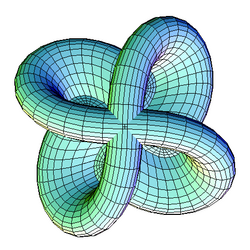Regular homotopy
In the mathematical field of topology, a regular homotopy refers to a special kind of homotopy between immersions of one manifold in another. The homotopy must be a 1-parameter family of immersions. Similar to homotopy classes, one defines two immersions to be in the same regular homotopy class if there exists a regular homotopy between them. Regular homotopy for immersions is similar to isotopy of embeddings: they are both restricted types of homotopies. Stated another way, two continuous functions [math]\displaystyle{ f,g : M \to N }[/math] are homotopic if they represent points in the same path-components of the mapping space [math]\displaystyle{ C(M, N) }[/math], given the compact-open topology. The space of immersions is the subspace of [math]\displaystyle{ C(M, N) }[/math] consisting of immersions, denoted by [math]\displaystyle{ \operatorname{Imm}(M, N) }[/math]. Two immersions [math]\displaystyle{ f, g: M \to N }[/math] are regularly homotopic if they represent points in the same path-component of [math]\displaystyle{ \operatorname{Imm}(M,N) }[/math].
Examples
Any two knots in 3-space are equivalent by regular homotopy, though not by isotopy.

The Whitney–Graustein theorem classifies the regular homotopy classes of a circle into the plane; two immersions are regularly homotopic if and only if they have the same turning number – equivalently, total curvature; equivalently, if and only if their Gauss maps have the same degree/winding number.

Stephen Smale classified the regular homotopy classes of a k-sphere immersed in [math]\displaystyle{ \mathbb R^n }[/math] – they are classified by homotopy groups of Stiefel manifolds, which is a generalization of the Gauss map, with here k partial derivatives not vanishing. More precisely, the set [math]\displaystyle{ I(n,k) }[/math] of regular homotopy classes of embeddings of sphere [math]\displaystyle{ S^k }[/math] in [math]\displaystyle{ \mathbb{R}^n }[/math] is in one-to-one correspondence with elements of group [math]\displaystyle{ \pi_k\left(V_k\left(\mathbb{R}^n\right)\right) }[/math]. In case [math]\displaystyle{ k = n - 1 }[/math] we have [math]\displaystyle{ V_{n-1}\left(\mathbb{R}^n\right) \cong SO(n) }[/math]. Since [math]\displaystyle{ SO(1) }[/math] is path connected, [math]\displaystyle{ \pi_2(SO(3)) \cong \pi_2\left(\mathbb{R}P^3\right) \cong \pi_2\left(S^3\right) \cong 0 }[/math] and [math]\displaystyle{ \pi_6(SO(6)) \to \pi_6(SO(7)) \to \pi_6\left(S^6\right) \to \pi_5(SO(6) \to \pi_5(SO(7)) }[/math] and due to Bott periodicity theorem we have [math]\displaystyle{ \pi_6(SO(6))\cong \pi_6(\operatorname{Spin}(6))\cong \pi_6(SU(4))\cong \pi_6(U(4)) \cong 0 }[/math] and since [math]\displaystyle{ \pi_5(SO(6)) \cong \mathbb{Z},\ \pi_5(SO(7)) \cong 0 }[/math] then we have [math]\displaystyle{ \pi_6(SO(7))\cong 0 }[/math]. Therefore all immersions of spheres [math]\displaystyle{ S^0,\ S^2 }[/math] and [math]\displaystyle{ S^6 }[/math] in euclidean spaces of one more dimension are regular homotopic. In particular, spheres [math]\displaystyle{ S^n }[/math] embedded in [math]\displaystyle{ \mathbb{R}^{n+1} }[/math] admit eversion if [math]\displaystyle{ n = 0, 2, 6 }[/math]. A corollary of his work is that there is only one regular homotopy class of a 2-sphere immersed in [math]\displaystyle{ \mathbb R^3 }[/math]. In particular, this means that sphere eversions exist, i.e. one can turn the 2-sphere "inside-out".
Both of these examples consist of reducing regular homotopy to homotopy; this has subsequently been substantially generalized in the homotopy principle (or h-principle) approach.
Non-degenerate homotopy
For locally convex, closed space curves, one can also define non-degenerate homotopy. Here, the 1-parameter family of immersions must be non-degenerate (i.e. the curvature may never vanish). There are 2 distinct non-degenerate homotopy classes.[1] Further restrictions of non-vanishing torsion lead to 4 distinct equivalence classes.[2]
References
- ↑ Feldman, E. A. (1968). "Deformations of closed space curves" (in en). Journal of Differential Geometry 2 (1): 67–75. doi:10.4310/jdg/1214501138.
- ↑ Little, John A. (1971). "Third order nondegenerate homotopies of space curves" (in en). Journal of Differential Geometry 5 (3): 503–515. doi:10.4310/jdg/1214430012.
- Whitney, Hassler (1937). "On regular closed curves in the plane". Compositio Mathematica 4: 276–284. http://www.numdam.org/numdam-bin/item?id=CM_1937__4__276_0.
- Smale, Stephen (February 1959). "A classification of immersions of the two-sphere". Transactions of the American Mathematical Society 90 (2): 281–290. doi:10.2307/1993205. http://www.maths.ed.ac.uk/~aar/papers/smale5.pdf.
- Smale, Stephen (March 1959). "The classification of immersions of spheres in Euclidean spaces". Annals of Mathematics 69 (2): 327–344. doi:10.2307/1970186. http://www.maths.ed.ac.uk/~aar/papers/smale4.pdf.
 |

